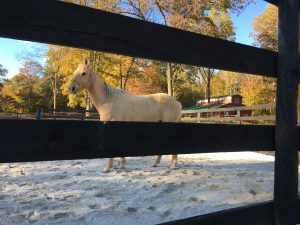My 21 year old daughter Bailey is a professional horse trainer. She works at a riding facility in Aumsville, Oregon – near Salem. Now Dad is pretty proud of her, as she has competed with the best in Tennessee and one of her horses was a national grand champion. The road to her dream occupation included some humble beginnings.
Bailey came to live with me full time when she was 11 and in fifth grade. She had always liked horses and needed to be kept busy after school. Nearby our home, was a riding stable, where Tennessee Walking horses were trained by Michele, a tough gal with a kind heart. I discussed Bailey’s situation with Michele and soon Bailey was starting her first job in her new career – mucking out horse stalls.
 The facility she worked at has 12’ x 12’ stalls in shedrows attached to both eave sides of a riding arena. Also, at the same facility, was a stall barn with 10’ x 10’ stalls on each side of an aisleway.
The facility she worked at has 12’ x 12’ stalls in shedrows attached to both eave sides of a riding arena. Also, at the same facility, was a stall barn with 10’ x 10’ stalls on each side of an aisleway.
Even at 11, Bailey was a pretty astute little business woman. The 10’ x 10’ stalls had to be cleaned out twice a day, while the 12’ x 12’ stalls were “once a day cleaners”. At a dollar a stall, she quickly could see it was to her advantage to make the smaller stalls her first choice.
The difference in cost between the small and large horse stalls, including the building size being increased, could have been made up in less than a year’s worth of the cost of cleaning the stall a second time every day. And a horse which has more room to move around within their stall is more content. This translates to less chewing, kicking, injuries and bottom line…fewer vet bills.
While ponies and small horses under 900 pounds may do just fine in 10’ x 10’ stalls – larger riding horses really require a 12’ x 12’ stall, which is the industry standard. The larger horse stalls also make the barn more versatile as well as appealing to future buyers who might have larger horses. A small draft horse may require a stall 14’ x 14’ and a large draft horse 16’ x 16’.
Foaling stalls can be created by arranging two 12’ x 12’ stalls adjacent to each other, with a removable partition in between. If you have stalls for rent, it’s a good idea to incorporate some flexibility in with your design, so stall sizes can be changed to fit the horse. If injured, a horse may need a larger stall to move around more during the recuperation period.
For normal riding horses a 10’ ceiling height is the bare minimum to help prevent a rearing horse from incurring head injuries. A 12’ height will be needed for warmbloods and larger draft horses.
The size of horse stalls is not a place to become penny wise and pound foolish. Make the small investment to do the job correctly the first time, as there is only one opportunity to do the job right – or wrong.






